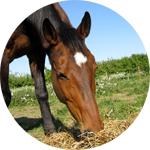
The feeding of horse hay alone provides sufficient energy for maintenance requirements i.e; grazing and digestive efficiency. When performance requirements are increased so are the horse’s energy requirements. The addition of concentrates (i.e; grains) containing a higher energy content enables these energy requirements to be met. As the energy demands placed on horses increase, so too does the proportion of grain to roughage required. It must be considered that the horse has evolved to digest roughage efficiently and consequently, in order to maintain gastrointestinal health, motility and minimize digestive dysfunction, roughage content must be supplied at adequate levels. It is important to note that the roughage content of your horse’s diet should not fall below 1% of their body weight and their total daily intake should be no less than 2%. For a 500kg horse that is 10kg per day. An average biscuit of hay weighs approximately 2kg, so in order to meet a 500kg horse’s minimum daily intake, you need to feed 5 biscuits a day to a stabled horse. This amount can be reduced if a hard feed is provided.
The only exceptions are growing weanling and yearling rations whose grain intake may increase up to 60% of the total ration.
Horse Hay & Chaff have the same nutritional value, but there is usually less waste with the feeding of chaff. Horse hay is the main source of fibre in the diet of the stabled horse and should be fed ad lib to simulate the grazing behaviour of a paddocked horse. Compared to grain, hay is lower and more slowly released energy source.
Types of Horse Hay:
LUCERNE- Good quality sun cured lucerne hay contributes significantly to the energy, protein, calcium, trace elements and vitamin content of a horses ration. It should be leafy, have a low proportion of coarse stems or seed heads and be free from mould and dust.
PASTURE HAYS- Grass and grass/legume hays are usually intermediate in quality between lucerne and cereal hays. They are a good fibre source for the horse in work as long as they are harvested before the plants mature.
CEREAL HAYS- The cereal hays (oaten, wheaten) are lower in calcium, energy, protein and vitamins than lucerne hay. Cereal hays must still contain some grain in the head to be of good quality.
Experts in Equine Nutrition
Every product in the Ranvet range has been developed to meet a horse’s most specific need at any given time, be it in a training environment or on a breeding farm. Having pioneered the formulation of specific medications and dietary supplements for horses, the company is now recognised as a leader in the areas of equine health and nutrition.
